

Within Timekeeping, Employees (in Abacus terminology ‘Staff’) in general perform work-services under the guidelines of one (or perhaps on some occasions more than one) Pay-Schedule (Payroll) --like Manager-Payroll vs. Server-Payroll vs. Administration-Payroll) -- and, under the premise of any particular Pay-Schedule, they can work in multiple Departments… and, within a Department, in one or more of the Department’s Job-Classes. In other words, an Employee is always “doing work” at any point in time under a particular Job-Class within a Department under the premises of a Pay-Schedule (Payroll type).
The TimeClock reacts to this type of Department and Job-Class differentiation when “Clocking In” – to ‘record’ the amount of Time spent doing work for a particular Department-JobClass situation.
The ‘time spent working’ under any Department & Job-Class (within a Pay-Schedule) is examined by the Timekeeping-to-Payroll process (under the rules of the Pay-Schedule) to determine how the ‘time’ should be classified over the Pay-Cycle – namely, how much is to be considered Regular-Time, Overtime, Double-Time.
Regular, Overtime, and DoubleTime are termed different Earnings Types (within a Payroll Pay-Schedule’s Department-JobClass) – for that pertinent Pay-Cycle.
During a Pay-Cycle, an Employee may also “make money” from doing Piecework, getting Tips, or getting a Flat-Amount (Salary)
All of these are also termed Earnings Types.
Within a Payroll (Pay-Schedule), the various Types of Earnings are sent (exported) from the Timekeeping System to the respective 3rd-Party Payroll System.
The Timekeeping-to-Payroll Interface (Export) is an Abacus 21 Optional Feature.
When an Export (of a Pay-Schedule’s Pay-Cycle information) from Abacus 21’s Timekeeping System is made to a 3rd-Party Payroll, it is sent (in general) as follow:
Per Pay-Schedule
Per Employee
Per Department
Per Job-Class (within Department) – Hours & Dollars:
Regular-Earnings
Overtime-Earnings
Doubletime-Earnings
Piecework-Earnings
Tip-Earnings
Salary-Earnings
The manner in which any respective Payroll System accommodates this varies… so, it is consequently necessary to establish “mappings” between Abacus 21’s Timekeeping definition of things and the Payroll System’s definition of things.
In this regard, the following Mappings are provided for:
Abacus Staff-Code to Payroll-System’s Employee-ID (defined in Staff Maintenance)
Abacus Department to Payroll-System’s Department (defined in Timekeeping System’s Department Setup)
Abacus Job-Class (within Department) to Payroll-System’s Job-Class (defined in Timekeeping System’s Job-Class Setup)
Abacus Earnings-Codes (within a Pay-Schedule) to Payroll-System’s Earnings Codes (defined in Timekeeping System’s Earnings-Codes Setups)
So… ultimately, each respective kind of Earning (Hours & Dollars) that an Employee might have in Abacus Timekeeping is routed to some kind of corresponding Earnings-Type in the Payroll System.
It is the Earning-Codes within the Payroll System that actually are used to create Journal Entries (by the Payroll System itself).
The Interface (Export transfer) of this information from Abacus Timekeeping to the 3rd-Party Payroll System in-and-of-itself does not create any Journal-Entry effect…. but rather merely exports the hour and dollar statistics – into a Payroll System Earnings-Entry Batch of some sort. It is the Payroll System itself that potentially might create Journal Entries for each of these Earnings etc…. at the time it posts the Earnings-Entry Batch is posted within the respective Payroll-System (if it is configured to generate Journal Entries of course).
The Import of 3rd-Party Payroll System Journal-Entries into Abacus 21 is an Abacus 21 Optional feature. The two types of imports associated with this are:
Posting of Earnings Register J/E’s to Abacus General Ledger
Posting of Payroll Pay Register J/E’s to Abacus General Ledger
The following are Screen Shot examples of some of the setups pertinent to establishing a Timekeeping-to-Payroll connection.
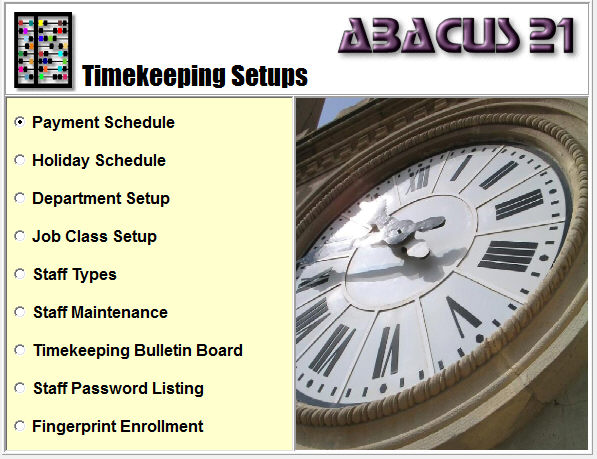
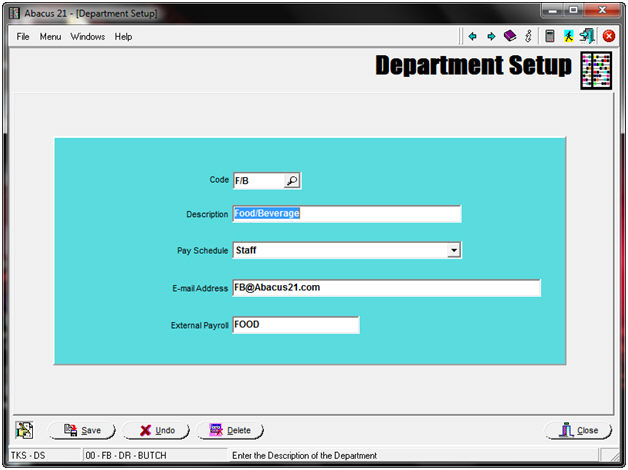
Department Setup… where the Department is affiliated with a Pay-Schedule and the (External, 3rd-Party) Payroll System’s corresponding ‘Code’ for the Department.
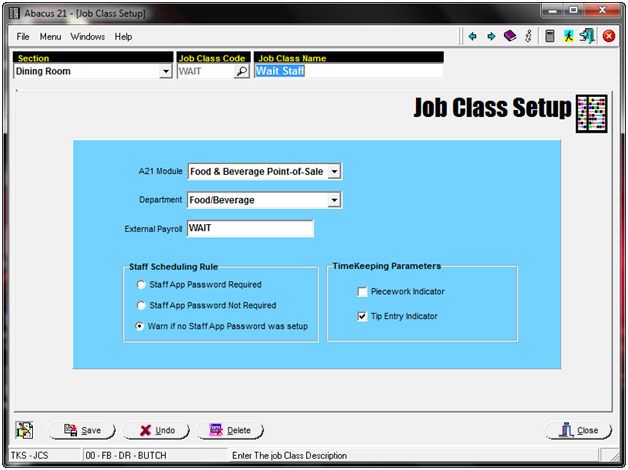
Job-Classes are created within respective Sections… are in turn aligned with a respective Department – as well as being ‘connected’ to the External Payroll System’s ‘Code’ for the Job-Class.
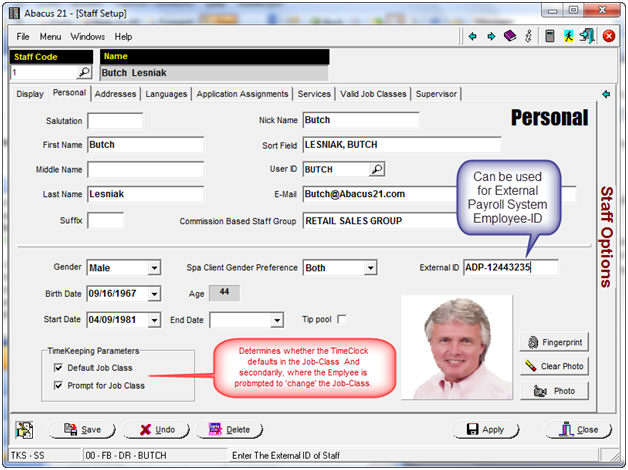
The above is the ‘Personal’ tab of Staff Maintenance.
The External-ID can be used to reference a 3rd-Party Payroll System’s Employee-ID for the Staff person.
Note also the provision for triggering the TimeClock to:
Default in a Job-Class (see Primary Job-Class designation below).
Set up to Allow the Employee to “change” the Job-Class when Clocking-In.
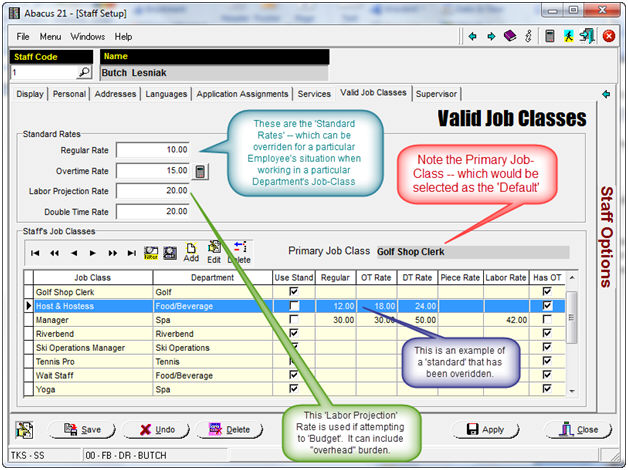
The above is the ‘Valid Job Classes’ Tab on Staff-Maintenance.
These are the ‘allowable’ Job-Classes (within Departments) that are established for this Employee – along with declaration of whether that Employee will word under the “Standard” Rates for that Job-Class… or specifically-different Rates.
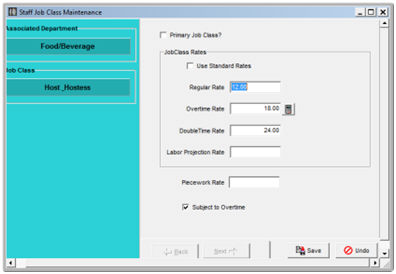
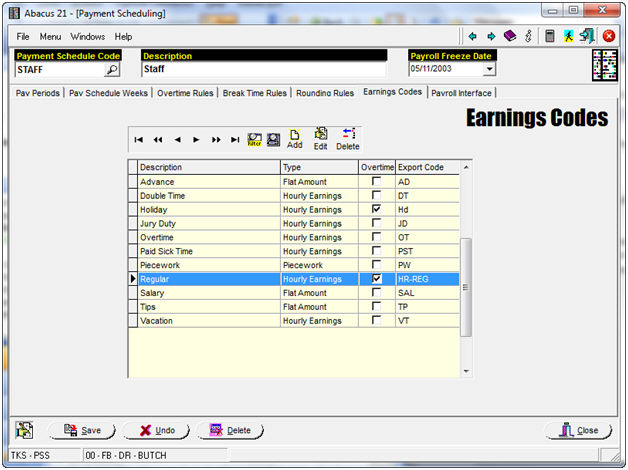
Earnings Codes are defined per Payment-Schedule.
There can be as many Earnings Codes set up as are relevant… however, each of them is designated to be of a particular Abacus-defined Earnings-Type:
Flat Amount (including Salary)
Hourly Earnings
Piecework
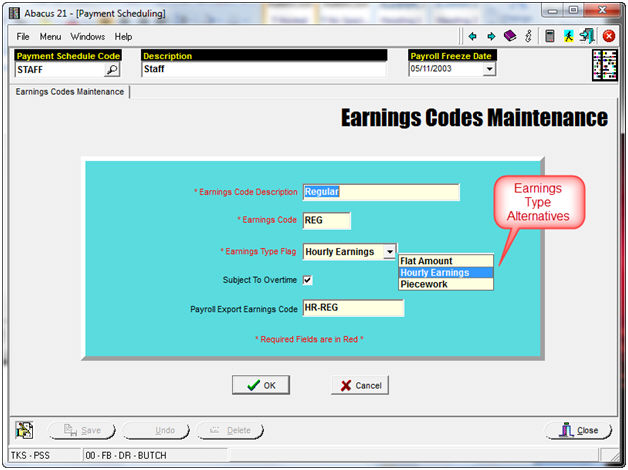
Each Earnings Code is linked to the Payroll System’s corresponding Earnings Code (ie. the ‘Payroll Export Earnings Code’).
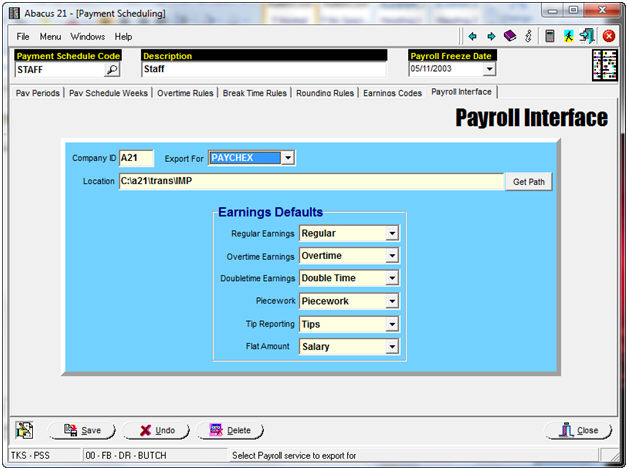
Finally, each of classical types of Earnings (from a Payroll System’s perspective) are ‘mapped’ to the corresponding Earnings-Code in Abacus.